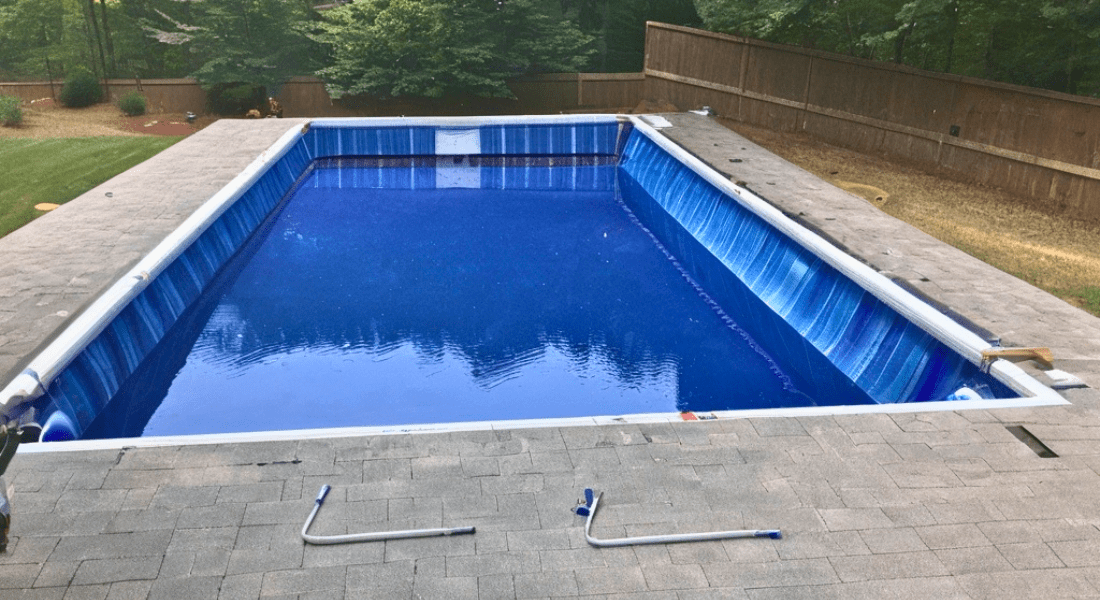A worn-out or damaged pool liner can turn your swimming pool into a source of frustration. Faded colors, visible tears, and constant leaks not only detract from the beauty of your pool but also lead to costly repairs and maintenance issues. These problems can make enjoying your pool seem more like a chore than a pleasure. Fortunately, replacing your pool liner can solve these issues, restoring your pool’s appearance and functionality.
In this comprehensive guide, we’ll explore everything you need to know about pool liner replacement, from understanding costs and types to mastering DIY installation. Whether you’re a seasoned DIY enthusiast or prefer professional help, this article provides valuable insights to make your pool liner replacement a smooth and successful project.
What is a Pool Liner and Why is it Important?
A pool liner is a vinyl layer that covers the walls and floor of a swimming pool, providing a smooth and attractive surface. It protects the pool structure from damage and leaks, and it contributes significantly to the overall aesthetics of your pool. Vinyl pool liners are popular for their durability and relatively low maintenance requirements, making them a preferred choice for many pool owners.
Pool liners come in various types, including beaded, overlap and unibead liners. Each type has its unique features and installation methods, catering to different pool structures and preferences. Understanding the importance of a pool liner can help you appreciate why maintaining and replacing it when necessary is crucial for your pool’s health and longevity.

How to Know When Your Swimming Pool Liner Needs to be Replaced
Recognizing when your pool liner needs to be replaced is essential to prevent more significant problems down the line. Here are some signs that it’s time for a replacement:
- Visible tears: Any rips or holes in the liner are clear indicators.
- Fading colors: Significant discoloration suggests wear and tear.
- Wrinkles: Wrinkling or stretching can indicate that the liner is no longer fitting properly.
- Water leaks: Rapidly dropping water levels may signal a leak in the liner.
Another indicator is the feel of your pool liner. If the liner feels brittle or rough to the touch, it’s likely reaching the end of its lifespan. Pool liners typically last between 7 to 10 years, but this can vary based on factors like the thickness of the liner, pool usage, and maintenance practices.
Types of Pool Liners: Which One is Right for Your Pool?
Choosing the right type of pool liner is crucial for ensuring a perfect fit and long-lasting performance. The three main types of pool liners are beaded, overlap, and unibead liners.
- Beaded Liners: These liners have a bead at the top edge that fits into a track around the pool’s perimeter. They are easy to replace and come in various patterns and designs.
- Overlap Liners: These liners are pulled over the edge of the pool and secured with coping strips. They are a cost-effective option and are relatively simple to install.
- Unibead Liners: Also known as J-hook liners, these can be installed as either beaded or overlap liners, offering flexibility in installation.
Selecting the best pool liner depends on your pool type, budget, and personal preferences. Vinyl inground pool liners, for example, are specifically designed for inground pools and provide a tailored fit and enhanced durability.
Understanding Pool Liner Replacement Costs
The cost of replacing a pool liner varies based on several factors, including the type of liner, pool size, and labor costs if you’re hiring a professional. On average, the pool liner replacement cost ranges from $1,000 to $3,500 for vinyl liners. This cost includes the liner itself, labor for installation, and any additional materials needed for the job.
Liner replacement cost by type can also differ, with beaded liners typically costing more to install than overlap liners due to their more complex installation process. It’s essential to budget for these costs and consider the long-term benefits of investing in a high-quality liner.
DIY Pool Liner Replacement: Is it Worth the Effort?
Replacing a pool liner yourself can save you money, but it requires careful planning and execution. DIY pool liner replacement involves several steps, including draining the pool, removing the old liner, preparing the pool surface, and installing the new liner. While the process can be labor-intensive, it’s doable with the right tools and guidance.
However, DIY pool liner replacement is not without its challenges. Ensuring a wrinkle-free installation and proper alignment can be tricky, and mistakes can lead to costly repairs. For those confident in their DIY skills, replacing a pool liner can be a rewarding project. For others, hiring a pool professional might be a safer and more convenient option.
New Pool Liner Installation: Step-by-Step Guide
- Drain Your Pool: Begin by draining the pool completely to remove the old liner.
- Remove the Old Liner: Carefully cut and remove the existing liner, ensuring not to damage the pool structure.
- Prepare the Pool Surface: Clean the pool surface thoroughly and repair any imperfections.
- Install the New Liner: Place the new liner in the pool, ensuring it’s centered and properly aligned. Start filling the pool with water while smoothing out wrinkles.
- Secure the Liner: Attach the liner to the pool edges using the appropriate method (beaded, overlap or unibead).
- Finish and Refill: Once the liner is secure, continue filling the pool with water and reinstall any fittings or accessories.
Following these steps meticulously ensures a smooth and successful liner installation, enhancing the appearance and functionality of your pool.
Common Challenges in Pool Liner Replacement and How to Overcome Them
Replacing a pool liner can present several challenges, including dealing with wrinkles, ensuring proper alignment, and managing water levels during installation. Wrinkles in the liner can be smoothed out by working from the center outward, using a pool brush or your hands.
Proper alignment is crucial to avoid future issues. Take your time during the initial placement of the liner and use measurements to ensure it fits correctly. Managing water levels involves filling the pool gradually while adjusting the liner to maintain a snug fit and avoid air pockets.
Maintaining Your Pool Liner for Longevity
Proper maintenance can significantly extend the lifespan of your pool liner. Regularly clean your pool to prevent debris buildup, which can cause abrasion and damage to the liner. Use a pool cover when the pool is not in use to protect the liner from UV rays and environmental contaminants.
Balancing your pool’s water chemistry is also vital. High chlorine levels or imbalanced pH can weaken the liner material, leading to premature wear and tear. Routine inspections for signs of damage or wear can help you address issues early and prevent costly repairs.
The Role of Pool Size and Shape in Liner Selection
The size and shape of your pool play a significant role in selecting the right liner. Custom pool shapes may require tailored liners to ensure a perfect fit, while standard shapes like rectangles or ovals have more readily available options.
Measuring your pool accurately is essential for a proper liner fit. Take multiple measurements of the pool’s length, width, and depth, and consider any unique features like steps or ledges. A well-fitted liner not only enhances the pool’s appearance but also ensures optimal performance and longevity.
Hiring a Pool Professional for Liner Replacement: What to Expect
Hiring a pool professional for liner replacement can provide peace of mind and ensure a high-quality installation. A professional will handle all aspects of the process, from draining the pool and removing the old liner to installing the new one and making any necessary adjustments.
Expect to pay a premium for professional services, but consider the benefits of expertise, efficiency, and a warranty on the work performed. When choosing a pool professional, look for experienced and reputable contractors with positive reviews and a proven track record.
Key Takeaways
- Importance of Pool Liners: Protects the pool structure, enhances aesthetics, and provides a smooth swimming surface.
- Signs of Replacement: Tears, fading, wrinkles, leaks, and a rough feel indicate the need for a new liner.
- Types of Liners: Beaded, overlap, and unibead liners each offer unique features and installation methods.
- Cost Considerations: Replacement costs vary based on liner type, pool size, and labor costs.
- DIY vs. Professional: DIY replacement can save money but requires careful planning; professionals offer expertise and convenience.
- Installation Steps: Draining, removing the old liner, surface preparation, installing the new liner, securing, and refilling.
- Maintenance Tips: Regular cleaning, water chemistry balance, and inspections extend liner life.
- Pool Size and Shape: Accurate measurements and custom fittings ensure a proper liner fit.
- Hiring Professionals: Offers peace of mind with expert installation and warranties.By understanding these aspects of pool liner replacement, you can make informed decisions that ensure your swimming pool remains a beautiful and enjoyable oasis for years to come.For more inspiration on enhancing your outdoor space, be sure to read our blog “Transform Your Backyard into a Pool and Spa Paradise.” It’s filled with creative ideas and practical tips to make your backyard the ultimate retreat. Ready to keep your pool in perfect condition? Jump into our next blog post and become a pool maintenance expert with Sutton Pools!
FAQs
How often should a pool liner be replaced?
A pool liner should generally be replaced every 7 to 10 years, although this can vary based on the liner’s quality, pool maintenance, and usage levels. Signs that it’s time for a replacement include visible tears, fading, wrinkles, and leaks. Regular inspections and proper care can help extend the lifespan of a pool liner, but proactive replacement is essential to prevent more significant damage to the pool structure.
Can I replace my own pool liner?
Yes, you can replace your own pool liner if you have the necessary skills and tools. While DIY replacement can save money, it requires careful planning and attention to detail. The process involves draining the pool, removing the old liner, preparing the pool surface, and installing the new liner. Although it’s labor-intensive, many pool owners successfully complete it on their own. However, if you’re not confident in your abilities, hiring a pool professional can ensure a proper and hassle-free installation.
Why are pool liners so expensive?
Pool liners are expensive due to the high-quality vinyl used for durability, precise manufacturing processes, customization for non-standard pool shapes, and the cost of professional installation labor. Investing in a high-quality liner is essential for maintaining the pool’s integrity and aesthetics, which justifies the expense.
How to tell if a pool liner is bad?
You can tell a pool liner is bad if it has visible tears or holes, significant fading or discoloration, wrinkles, stretching, or sagging, and if you experience unexplained water loss indicating leaks. Additionally, a brittle, rough, or rigid texture suggests that the liner is old and losing its flexibility, making it more prone to damage. Regular inspections and addressing issues early can prevent severe pool damage and extend the liner’s lifespan.


